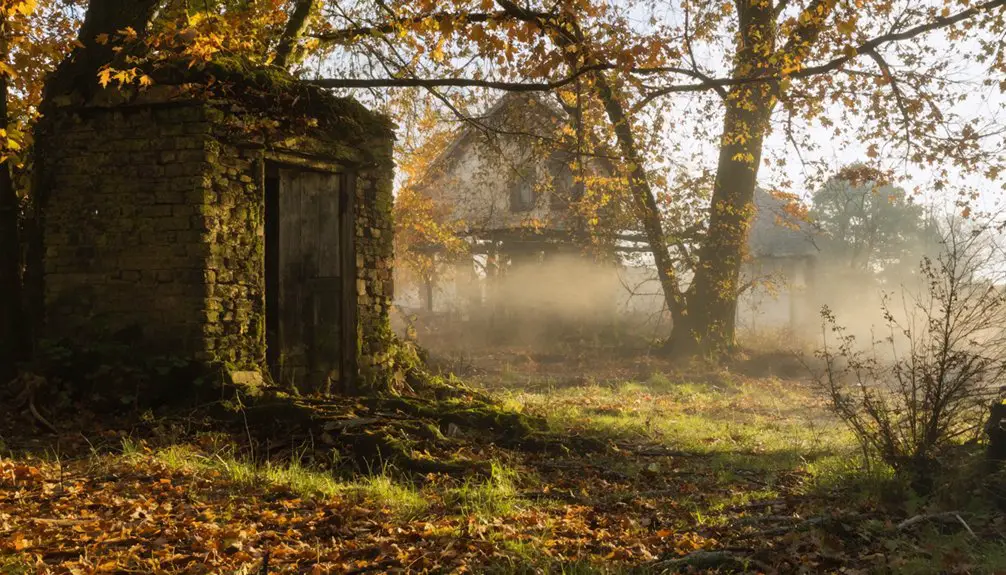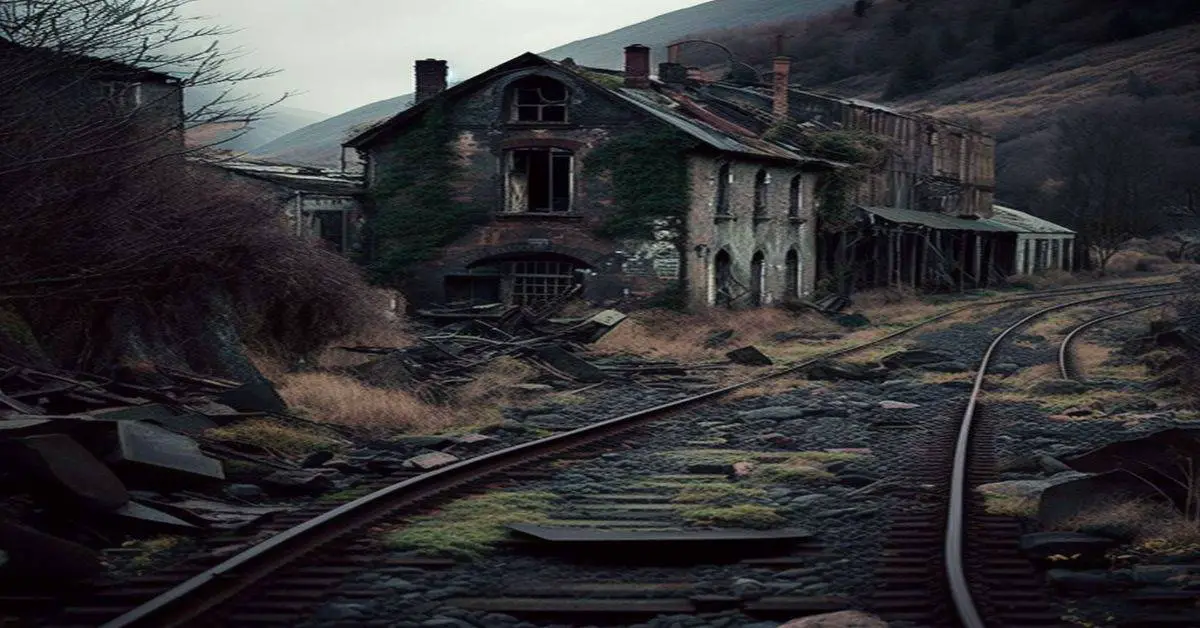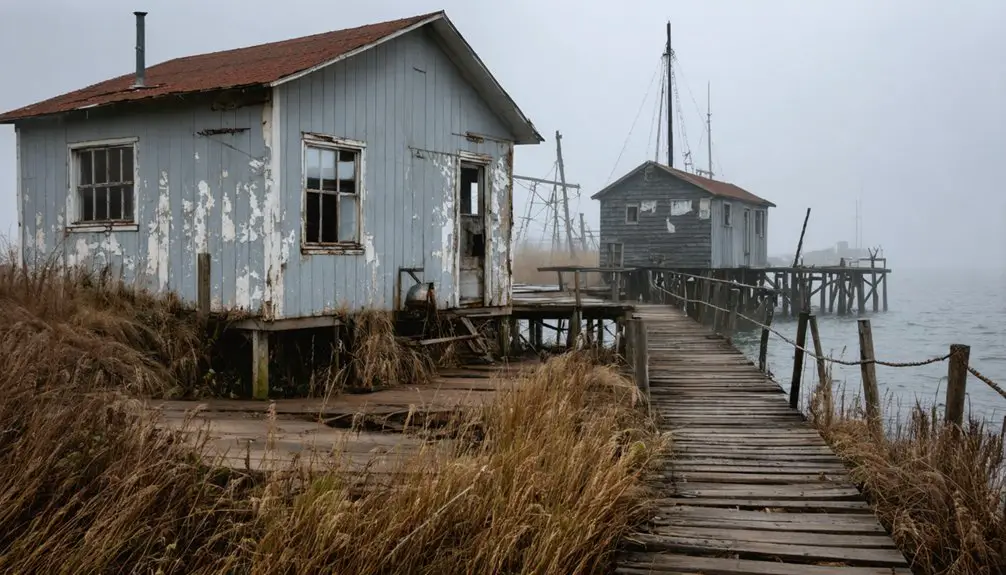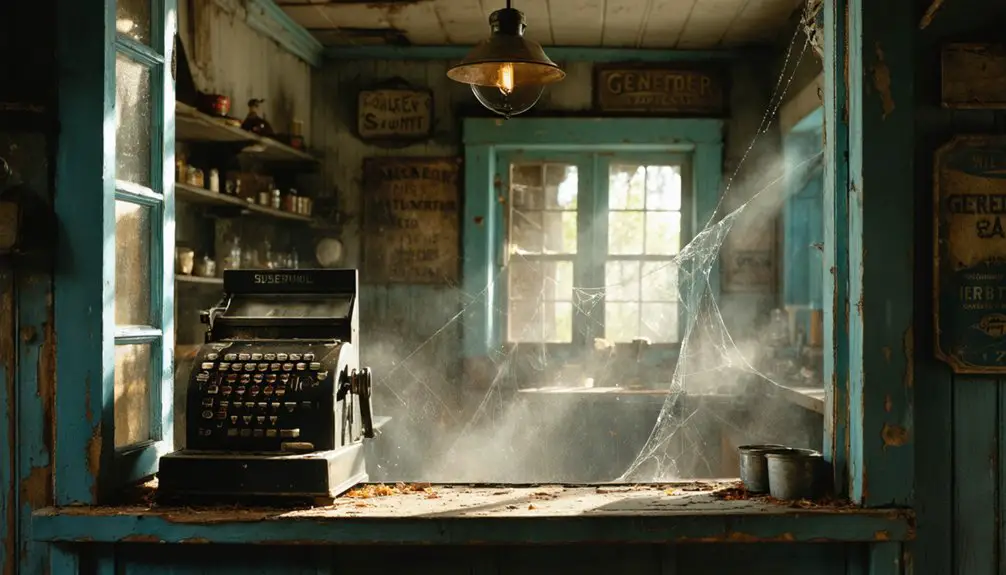You’ll find the haunting remains of Muskego Settlement, Wisconsin’s first major Norwegian immigrant community, established in 1839 by John Nielsen Luraas and forty pioneers. While the settlement initially thrived with a Lutheran congregation and post office near Tess Corners, devastating cholera epidemics in 1849 and 1851 forced survivors to abandon their homes and deceased loved ones. The ghostly legacy lives on through unmarked graves, folklore, and the mysterious tales of Haunchyville that emerged in later years.
Key Takeaways
- Muskego Settlement, established in 1839 by Norwegian immigrants, became abandoned after devastating cholera epidemics in 1849 and 1851.
- Disease outbreaks led to mass graves and unmarked burial sites, with makeshift hospitals in barns becoming temporary morgues.
- Survivors fled the settlement, leaving behind deceased family members and abandoned homesteads due to the severe health crisis.
- The original settlement area contains remnants of pioneer life, including abandoned cemeteries and foundations of early structures.
- Modern ghost tours and heritage festivals preserve the memory of this ghost town, sharing stories of the Norwegian settlers’ tragic fate.
The Norwegian Pioneer Spirit
When John Nielsen Luraas led the first group of Norwegian pioneers to Muskego in 1839, he established what would become a pivotal settlement for Norwegian-American immigration.
The pioneer resilience of early settlers like Søren Tollefsen Bache and Johannes Johannsen transformed the wilderness into a thriving community, purchasing land tracts and encouraging others to join them from their homeland. Even Hansen Heg contributed significantly by creating a transit center for immigrants in 1843. The journey to their new home was treacherous, taking seventeen weeks from Skien to Milwaukee.
Through unwavering determination, Norwegian pioneers carved a welcoming haven from untamed wilderness, beckoning fellow countrymen to join their American dream.
You’ll find evidence of their cultural perseverance in how they adapted Norwegian rural traditions to Wisconsin’s landscape, settling near lakes and forests in ways that mirrored their homeland.
The pioneers’ determination manifested in the construction of America’s first Norwegian Lutheran church, built despite limited funds.
Their spirit lives on through the Muskego Manifesto of 1845, which boldly defended their right to seek freedom and prosperity in America.
Early Settlement Years (1839-1848)
In 1839, you’d find John Nielsen Luraas leading forty Norwegian pioneers to establish Muskego Settlement around the marshy banks of Muskego Lake, where they staked out 640 acres across Waukesha and Racine Counties.
The area’s first post office was established near Tess Corners that same year, serving as a vital communication hub for the growing settlement.
These settlers actively encouraged more Norwegians to join their community, strengthening their cultural presence in Wisconsin.
You can trace how these settlers quickly adapted from pure farming to establish trading networks with Milwaukee while building Wisconsin’s first Norwegian Lutheran congregation in 1843.
Norwegian Pioneers Lead Way
Under the leadership of John Nielsen Luraas, roughly forty Norwegian pioneers established the Muskego Settlement in 1839, marking the beginning of significant Norwegian immigration to Wisconsin.
Key figures like Søren Tollefsen Bache and Johannes Johannsen helped organize the growing community, while religious leaders Elling Eielsen and Claus Lauritz Clausen provided spiritual guidance through America’s first Norwegian Lutheran congregation.
Even Heg’s farm became a crucial hub, serving as both trading post and mail center for the settlers. Monthly wages of fifteen to twenty dollars allowed immigrants to slowly build their savings for land purchases.
The community’s influence extended beyond its borders through “America Letters” and publications that encouraged more Norwegian immigration.
The settlement published the first Norwegian newspaper in America, furthering its cultural impact throughout the region.
When Johannsen penned the Muskego Manifesto in 1845, defending emigration against Norwegian government criticism, he strengthened the settlement’s role as a gateway for Norwegians seeking opportunities in Wisconsin and westward.
Land Claims and Growth
Following the Potawatomi’s 1833 land cession at 4.5 cents per acre, European settlers began staking their claims throughout the Muskego area. Luther Parker led the way in 1836, while Norwegian immigrants under John Nielsen Luraas secured 640 acres by 1839.
You’ll find that community growth centered around strategic locations, with settlers establishing claims near the muskeg lakeshore and fertile farming lands. The first post office opened in 1839 near Tess Corners, and by 1848, Muskego Centre emerged as the area’s hub. Irish immigrant families like John Burns’ homestead helped establish thriving agricultural operations, converting wilderness into productive farmland.
Land claims expanded steadily as Norwegian pioneers, guided by the Nattestad brothers’ recommendations, acquired substantial agricultural plots. The Muskego Manifesto of 1845 further accelerated settlement, drawing more immigrants while strengthening community bonds across county lines.
Cultural Identity Takes Root
The vibrant Norwegian cultural identity of Muskego took root when John Nielsen Luraas led forty pioneers from Norway’s Telemark region to establish the settlement in 1839.
You’ll find that these settlers quickly built institutions to preserve their heritage, establishing America’s first Norwegian Lutheran congregation by 1843. The church became their cultural anchor, serving as both a spiritual center and a gathering place for immigrant families seeking connection to their homeland.
Johannes Johannsen’s 1845 Muskego Manifesto boldly defended the settlers’ right to emigrate, while the settlement’s first Norwegian-American newspaper strengthened cultural preservation efforts. The publication of Nordlyset in 1847 marked a significant milestone in Norwegian-American journalism.
Leaders like Even Heg and Claus Clausen fostered strong immigrant identity through religious services, education, and community gatherings.
Despite challenges, you’ll see how Muskego’s influence spread, becoming a mother colony for Norwegian-American culture across the frontier.
Disease and Devastation
As you walk through the abandoned Muskego settlement, you’ll find traces of the devastating cholera epidemics that struck in 1849 and 1851, claiming countless Norwegian immigrant lives.
The early settlers were already weakened by malaria-carrying mosquitos before the cholera outbreaks began.
Like many other ethnic enclaves across Wisconsin, Muskego provided Norwegian immigrants a sense of cultural familiarity before disease struck.
You can still locate the remnants of the makeshift hospital barn by Big Muskego Lake, where desperate settlers sought treatment without proper medical knowledge or sanitation.
The sight of pre-dug open graves awaiting the mounting death toll reflects the community’s grim acceptance of cholera’s inevitable spread through the settlement.
Cholera’s Deadly Toll
Devastating cholera outbreaks struck Muskego Settlement twice between 1849 and 1851, decimating the Norwegian immigrant community and ultimately leading to its abandonment.
The first epidemic response came when newly arrived immigrants, unfamiliar with cholera myths and prevention methods, brought the disease in 1849. You’ll find records showing scores of victims were treated in a makeshift hospital – a converted barn near Big Muskego Lake.
When cholera resurged in 1851, the community established a log house hospital for quarantine near the town line.
The epidemics’ “frightful violence and fatality” mirrors the tragic fate of the earlier Beaver Creek settlement. These repeated outbreaks proved too much for the Norwegian families who’d built their lives here – most survivors fled, leaving Muskego to fade into history.
Abandoned Graves Await Death
During Muskego’s darkest days, settlers faced an unrelenting onslaught of diseases that claimed countless lives, from malaria and swamp fever to the dreaded cholera outbreaks.
You’ll find sobering evidence of their struggle in the abandoned cemeteries, where hastily dug graves stood ready to receive the next victims. The devastating death toll overwhelmed traditional memorial practices, forcing settlers to focus on survival rather than proper burial ceremonies.
- Graves were kept open in anticipation of mounting casualties
- Makeshift hospitals in barns and log houses became temporary morgues
- Many burial sites remained unmarked due to the urgency of mass fatalities
- Surviving families fled, leaving behind their deceased loved ones
- These abandoned gravesites stand as silent witnesses to the community’s collapse
Impact of the Cholera Epidemics
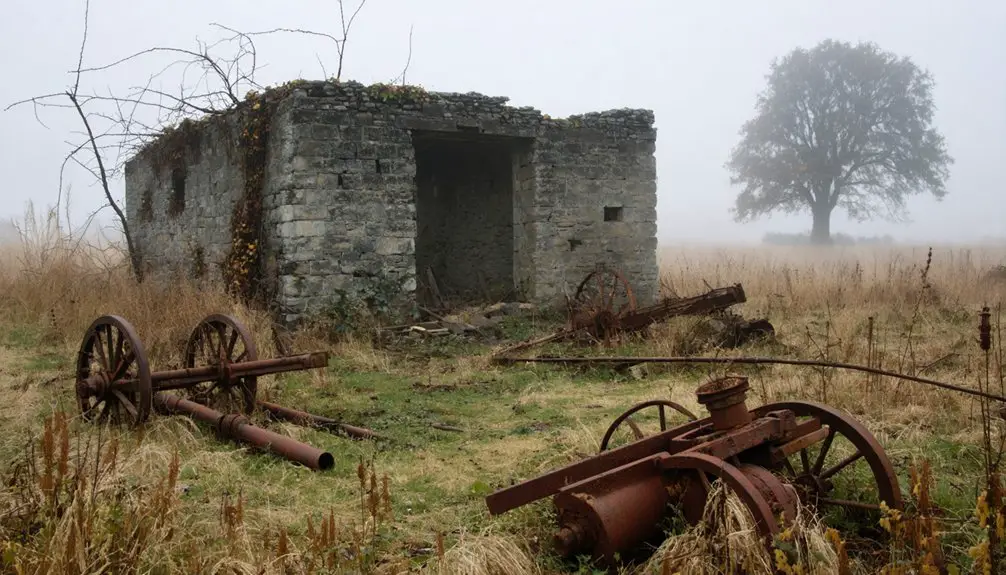
While Muskego Settlement faced numerous challenges in its early years, the cholera epidemics of 1849 and 1851 proved to be the most devastating blows to the fledgling community.
You’ll find that these outbreaks, described by one settler as the “awfullest summer,” nearly wiped out entire sections of the original population. The cholera impact wasn’t limited to just deaths – survivors often suffered long-term health effects that crippled the settlement’s growth.
The epidemics ultimately led to settlement abandonment as residents fled the contaminated, swampy conditions.
Though community leaders like Even Hansen Heg and James DeNoon Reymert established a hospital in 1852, their efforts came too late to save the original settlement site.
Many survivors relocated to other areas in southern Wisconsin, forever altering the region’s development patterns.
Muskego Manifesto’s Historical Influence
Published in 1845 as a powerful rebuttal to Norwegian anti-emigration propaganda, the Muskego Manifesto transformed the landscape of Norwegian-American immigration. This collective document, signed by eighty settlers and drafted by Johannes Johannsen, challenged Norway’s official stance while strengthening immigrant narratives across the Atlantic.
You’ll find its influence extended far beyond Muskego’s borders, creating lasting networks between Norway and America that shaped migration patterns for decades.
- Created a significant hub for Norwegian settlers in Wisconsin, similar to Plymouth Colony’s role for English immigrants
- Established community leaders like Johannsen and Bache as trusted voices for potential emigrants
- Connected immigrant families through newspapers and letters, maintaining essential homeland ties
- Promoted values of freedom and equality over Norway’s rigid class distinctions
- Legitimized the immigration movement during its controversial early phase
Life in the Frontier Community
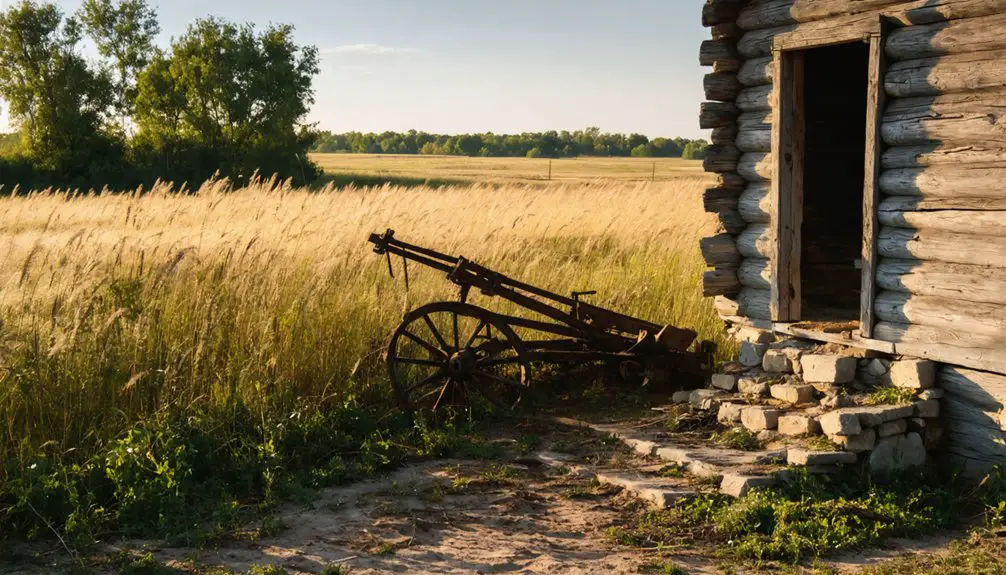
The frontier community of Muskego Settlement came to life in 1839 when forty Norwegian pioneers, led by John Nielsen Luraas from Telemark, established their homes in the Wisconsin wilderness.
You’d have found these settlers tackling frontier challenges head-on – clearing land once inhabited by the Potawatomi, building homes, and cultivating crops in unfamiliar soil.
Community resilience flourished through their Lutheran congregation, established in 1843, which served as both a spiritual anchor and social hub.
You’d have witnessed wagon trains bringing new settlers, while schools and churches strengthened communal bonds.
The settlers adapted to their environment by supplementing farming with hunting, fishing, and timber harvesting.
Despite harsh winters and isolation, they created a thriving community that bridged Waukesha and Racine counties, supporting each other through shared resources and cultural traditions.
The Birth of Haunchyville Legends
During the 20th century, a fascinating folklore emerged near the original Muskego Settlement – tales of mysterious “haunchies” or little people who’d made their home in a secluded enclave known as Haunchyville.
The Haunchyville folklore blended Norwegian settlers’ oral traditions with local Potawatomi influences, creating a unique cultural storytelling legacy that’s distinctly Midwestern.
You’ll find these legends deeply rooted in the community’s identity, separate from the area’s documented 19th-century settlement history.
- Locals describe shadowy figures no taller than 4 feet
- Dense woods hide a self-sufficient village of supernatural beings
- Stories warn visitors to respect unwritten rules or face consequences
- The legends serve as guardians of local mystery and tradition
- Regional media and tourism have embraced these enchanting tales
Geographic Evolution Over Time
Since its origins as a Potawatomi settlement called “Mus-kee-Guaac,” Muskego’s geographic landscape has undergone dramatic transformations shaped by waves of European settlement and changing land use patterns.
You’ll find that the area’s settlement patterns evolved from scattered Native American campsites to five distinct immigrant communities, each carving out their own territories: Yankees in Muskego Center, English in Durham Hill, Irish in Denoon, Germans in Tess Corners, and Norwegians near Lake Denoon.
The region’s geographic changes were heavily influenced by its natural features, particularly the marshy lands around Muskego Lake. Early settlers faced flooding challenges that forced some to relocate, especially the Norwegian colonists who moved to Wind Lake’s banks.
Modern Echoes of a Lost Settlement
Modern visitors to Muskego can still experience echoes of its pioneering past through popular Ghost Walk tours, heritage festivals, and preserved historical sites that keep the settlement’s legacy alive.
Step into Muskego’s pioneer heritage through ghostly evening tours, vibrant festivals and historic landmarks that preserve its remarkable early days.
You’ll discover rich cultural folklore woven into guided tours that blend historical education with entertainment, while ghost stories of the settlement’s challenging times add an atmospheric dimension to the experience.
- Annual reenactments bring pioneer-era tales to life on original settlement grounds
- Educational markers guide you through the Norwegian immigrant experience
- Local schools incorporate settlement history into hands-on field trips
- Ghost Walk tours explore abandoned buildings while sharing survival stories
- Regional myths, including the legendary Haunchyville, connect modern visitors to the area’s mysterious past through storytelling traditions
Frequently Asked Questions
What Role Did Women Play in the Early Development of Muskego Settlement?
You’ll find that women’s contributions shaped community survival through domestic management, while their social roles included preserving Norwegian culture, organizing gatherings, providing healthcare, and supporting essential agricultural work.
How Did Native American Tribes Interact With Norwegian Settlers in Muskego?
You’ll find limited records of cultural exchange between Native Americans and Norwegian settlers, though there’s evidence of cautious trade relationships focused on practical coexistence rather than significant social integration.
What Crops and Livestock Were Primarily Raised in Muskego Settlement?
Like pioneers carving their destiny, you’d find wheat and potatoes dominating the fields, while apple orchards dotted the landscape. You’d also see farmers raising pigs and chickens for sustenance.
Did Any Original Norwegian Structures From Muskego Settlement Survive to Present Day?
You’ll find few original Norwegian architecture examples survived at Muskego, though historical preservation efforts saved the 1844 Old Muskego Church by relocating it to Luther Seminary in St. Paul, Minnesota.
How Did Winter Weather Conditions Affect the Settlement’s Early Survival Rates?
You’ll find harsh winters severely tested settlers’ survival rates, forcing them to develop essential community strategies like resource sharing, shelter improvements, and food stockpiling to overcome deadly cold-weather threats together.
References
- https://www.americanghostwalks.com/blog/2019/06/27/253-haunchyville-wisconsins-miniature-murderers
- https://www.linkstothepast.com/waukesha/muskego1.php
- https://en.wikipedia.org/wiki/Muskego_Settlement
- https://www.jahernandez.com/posts/haunchyville-of-waukesha-county-wisconsin
- https://www.geotab.com/ghost-towns/
- https://wisconsinhistory.org/Records/Article/CS11357
- https://www.luthersem.edu/archives/old-muskego/
- https://townsquarepublications.com/muskego-wi-history/
- https://muskegohistory.wixsite.com/muskegohistory/history-of-muskego
- https://emke.uwm.edu/entry/norwegians/
